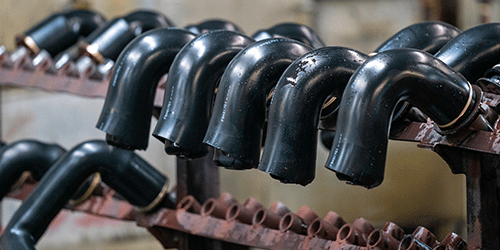Sperry & Rice has been in the rubber business since the 1940s and we might be a bit biased, but we believe that rubber is one of the most important substances on earth. Consider everything rubber is used for: protective gloves, balloons, roofing membranes, pencil erasers, wetsuits, boots and the soles of shoes, faucet washers, pond liners, lifeboats, bike tires and innertubes, insulation, and gaskets and seals for everything from car engines to washing machines.
And we can’t forget about tires. More than half of the supply of rubber goes into making tires for cars, trucks, buses, and airplanes.
Yes, rubber is important, and there are two types of rubber: natural and synthetic. Natural rubber is obtained from latex, a milky fluid found in about 2,500 species of plants. The biological function of why plants contain latex isn’t completely understood, but it helps plants heal damage and block the entry of harmful bacteria into the plants.
But this is all about synthetic rubber so let’s start with the basics.
Synthetic Rubber is any artificial elastomer, a material that can undergo elastic deformation and return to its previous size without permanently altering its shape. Synthetic rubber can be used in place of natural rubber, and in many instances, is preferred because of improved and specialized elastomeric properties.
The search to create synthetic rubber dates to the late 1880s but took on new urgency with the beginning of World War II. A military airplane required a half ton of rubber; a tank needed one ton; and each person in the military required 32 pounds of rubber for boots, clothing, and equipment. Not to mention tires for tens of thousands of motorcycles, jeeps, and trucks, so the need for rubber far exceeded available supply.
To produce the rubber needed for the war, the U.S. government enlisted the help of rubber companies, the petrochemicals industry, and university research laboratories, and was able to increase the synthetic rubber industry from an annual production volume of 231 tons in all of 1941 to around 70,000 tons a month in 1945. (American Chemical Society)
Today, about 70% of rubber used in manufacturing is synthetic, and is a descendant of the synthetic rubber-styrene produced for World War II.
There are about 20 types of chemicals that are used for making synthetic rubber varieties and each has individual properties and advantages; here are just a few synthetic rubber types:
For every application of rubber you see, there are 100 that you don’t see. Think about your car or truck. Of course, the tires are rubber, but so are its unseen hoses, belts, gaskets, weatherstripping, airbags, component covers and shrouds, pedal pads, o-rings, grommets, seals, and bushings.
Now, imagine how many times rubber is used in a building. Window and door seals, HVAC components, paints and sealants, expansion joints, roofing membranes, and anti-vibration mountings.
We are incredibly dependent on the use of both natural and synthetic rubber.
What makes synthetic rubber so vital is its wide variety of properties and ability to meet the requirements of many different industries:
As mentioned above, thanks to the variety of synthetic rubber formulations available, it can be made to withstand any conditions required of it, from hot to cold, acidic to alkaline, and everything in between. Synthetic rubber is resistant to solvents, oxygen, oils, and other chemicals which allow it a longer life, and it doesn’t lose its flexibility when exposed to wide range of weather conditions.
Synthetic rubber is used in everything from adhesives to latex gloves. Slightly harder, more durable, and less elastic synthetic rubber is used to make aircraft tires, hose pipes, and waterproof gaskets.
By industry, here is a breakdown of how synthetic rubber is used:
Rubber is an amazing material, and synthetic rubber comes in many types and shapes, with wide and varied properties. Sperry & Rice has been in the rubber business more than 70 years and offers innovative engineering, advanced manufacturing processes, and comprehensive quality controls to produce precision extruded synthetic rubber components for the HVAC, automotive, transportation, and appliance industries. Our reputation lies in making sure that the rubber we provide makes the finished products of our clients reliable, and of the highest quality.
For more information about how Sperry & Rice can be your custom extruded rubber partner, Contact Us!
